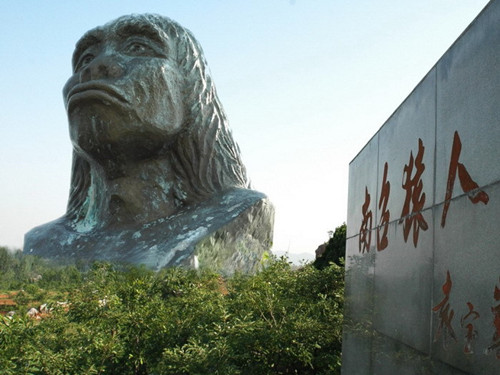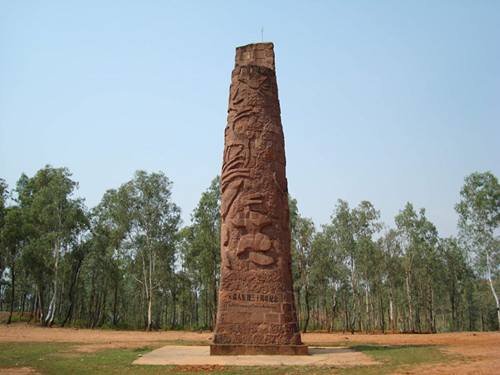
In 1965, fossils of Yuanmou Man were discovered in Yuanmou County, Yunnan Province. Yuanmou Man, who lived 1.7 million years ago was the first Homo erectus ever found within the boundaries of China. The two fossil teeth unearthed were from the inside upper jaw of a young male. In the same layer, stone chips and stone tools with traces of the work of man along with a three-meter-thick layer of earth containing carbon indicated that man had already begun to make simple tools and knew how to use fire. In 1929, a skull fossil of Peking Man who lived some 200,000 to 700,000 years ago was discovered in Zhoukoudian, Fangshan, in suburban Beijing.
The skull showed a brain capacity of 1,059 ml., lower than the average brain capacity of 1,400 ml. of modern man. Analysis shows that Peking Man had the ability of simple thinking and speaking, and could walk straight and engage in productive labor. From the same site, fossils of bones and teeth belonging to more than forty men and women of different ages were unearthed along with more than 100,000 pieces of roughly processed stone tools for cutting, smashing, chopping and trimming. Also found was a layer of accumulated ashes six meters thick and animal bones that had been burned, which suggested that Peking Man used fire to cook his food.

The origin of man is admittedly a matter of dispute in the field of modern natural science. In recent years, foreign scientists have come to the position after making use of molecular biological method in their research that the earliest ancestor of the modern man was born in Africa 200,000 years ago. From the molecular biological point of view, since people could mate among different ethnic groups, they came from the same distant ancestor.

Some scientists believe that the origin of modern man was an African woman who lived 200,000 years ago, and that some of her descendants arrived in the Middle East some 100,000 years ago. After that, another group arrived in East Asia and Europe about 60,000 years ago. Wherever they stopped, they wiped out the "aboriginals". Neanderthal Man in Europe and the Peking Man in China were collateral branches which became extinguished during man's evolutionary process.
Most of the palaeoanthropologists of China do not agree with this. The large amount of palaeoanthropological fossils found in China suggest that Yuanmou Man of 1.7 million years ago, New Cave Man of 100,000 years ago, Upper Cave Man of 18,000 years ago and Jalai Nur Man of 10,000 years ago all had high cheekbones, flat nose bridges and spade-shaped upper front teeth, which are all characteristics of modern man in China, indicating genetic stability and evolutionary continuity. In particular, the span of 330,000 years from Peking Man, to New Cave Man and Upper Cave Man, who all made their home in the Zhoukoudian area, effectively testifies to the fact that the yellow race evolved from a local ape.
Backed by solid proof, almost all of China's palaeoanthropologists support the theory of "regional evolution" of the origin of man.
In 1998, a group under the guidance of Professor Qiang Biqin of the Basic Medicine Research Institute of the Chinese Academy of Medical Science, and Professor Chen Zhu of the Shanghai Research Institute of Haematology of the Second Shanghai Medical University, together with Chu Jiayou, president of the Medicinal Biology Research Institute of the Chinese Academy of Medical Science, who was the leader of a sub-group, published their thesis titled, "Genetic Relations Among Different Human Groups in China" in the journal of the US Academy of Medical Science. The group made analyses of generic samples of 28 major groups including the Ewenkis in Heilongjiang in the far north, the Uygurs in Xinjiang in the far west, several branches of the Gaoshan people in Taiwan in the east and people in Yunnan in the south. Their studies suggested that the 56 ethnic groups in China showed genetic differences among people in the north and south, with the Yangtze River as the dividing line. The genome tree conforms with the theory of a single African origin. To this day, no proof has been found to support the theory of an independent origin in Asia, which differs from what the fossils suggest.
The results of the most recent study, made public in March 2000, however, once again favored scholars in China in their theory of human origin. The Shu Ape, a primate weighing only 100 to 150 grams and being similar to a mouse in size, lived in the Middle Eocene Epoch 4.5 to 4 million years ago. Its discovery posed a great challenge to the theory of African origin of the human race. When palaeontologists and research fellows Qi Tao and Wang Jingwen discovered the fossil of this advanced primate in Liyang, in east China's Jiangsu Province in the early 1990s, they named it the "China Shu Ape". "Shu" means the first light. They so named the animal because they wanted to suggest that its discovery had brought new hope for finding the common ancestor of the human race and advanced primates. At the same time, it also meant that the place of origin of the advanced primate might well have been in China.
The Shu Ape is to date the smallest primate animal ever discovered. Carrying the characteristics of both the advanced and lower primates, it was the link between the lower to the advanced primates. It was good at climbing, and walked on all fours on tree branches. Its diet was wide-ranging -- from insects to fruits. Fossils of this ape have been found in Liyang in Jiangsu Province and Yuanyang in Shanxi Province in China and earth formation at Pondug in Myanmar. All of these places were temperate, damp forested areas crisscrossed by rivers, a suitable environment for the Shu Ape.
Professor and palaeontologist Daniel L. Gebo of Northern Illinois University has said that most scientists believed that the ancestor of advanced primate animals came from Africa, but the importance of the regions where the Shu Ape was found suggests the unusual aspects of Asian fossil sites. Chinese palaeontologist Qi Tao believes that the discovery of the Shu Ape fossils solved two issues: One was that it pushed back the time of origin of advanced primates by 10 million years, and the other was that it moved the place of origin of advanced primates from Africa to East Asia. The discovery's great significance poses a strong challenge to the important position the African continent has so far held in theories of man's evolution.
Admission Fee:¥0

You will only receive emails that you permitted upon submission and your email address will never be shared with any third parties without your express permission.
